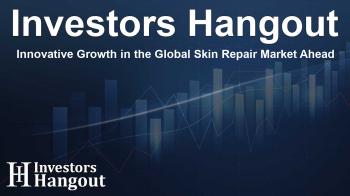Innovative Growth in the Global Skin Repair Market Ahead

Vision for the Skin Repair Market's Future
The skin repair market is on an impressive trajectory, moving from a valuation of US$ 81.67 billion in 2024 to an anticipated US$ 149.52 billion by 2033. This transformation is driven by a compound annual growth rate (CAGR) of 6.95%, showcasing a market dynamic spurred by evolving consumer needs and technological advancements.
Advancements in Skin Repair Solutions
The surge in skin repair solutions stems from a combination of innovative drug developments and increasing market demands. In the United States, skin treatments are growing at an annual rate of 4.73%. This uptick is mirrored by a 10% to 12% increase in prescription drug spending, suggesting a strong consumer reliance on effective treatments. Notably, topical creams and ointments account for 30% of the total skin repair market, highlighting their widespread acceptance.
Growth in Specialized Treatments
Among the fastest-growing segments is diabetic foot ulcers, alongside prevalent conditions like acne and atopic dermatitis, which affect millions. The global landscape is expected to see a remarkable CAGR of 11.5% in dermatological products from 2025 to 2030. Notably, the primary consumers driving this demand are individuals aged 20 to 30, with a marked preference for innovative and natural solutions.
Technological Integration in Skin Repair Development
As the industry advances, the integration of technology plays a pivotal role in growth. The adoption of artificial intelligence (AI) and personalized care methodologies enhances the quality of skincare. With AI diagnostic tools processing over 1 million images daily, dermatologists are reducing diagnostic errors, fostering a trend toward tailored skincare strategies.
The Role of Nanotechnology
Nanotechnology is revolutionizing how active ingredients penetrate the skin, and over 500 new products deployed with nanoparticles are changing consumer experiences. Recently, therapeutic innovations such as cell-based therapies and bioengineered skin grafts are being increasingly researched. This dual focus on innovation and traditional therapies sets the stage for a comprehensive, patient-centered approach to skin repair.
The Impact of Consumer Behavior
With more than 75 million U.S. consumers incorporating advanced skin repair solutions into their routines, consumer behavior is shifting towards informed choices. Educational efforts reaching over 20 million individuals are further encouraging consumers to engage more knowledgeably with skin health, promoting trust in products and their efficacy.
Preference for Sustainability
The demand for eco-friendly and sustainable products has prompted over 5,000 skincare brands to adopt responsible production practices. Recycling efforts are expected to save significant amounts of plastic waste annually while certifications for cruelty-free practices ensure that consumers align their purchases with ethical values.
Navigating Regulatory Dynamics in the Industry
As the skin repair market evolves, regulatory bodies continue to enhance the standards of product safety. The recent FDA mandates for the comprehensive assessment of skincare ingredients reflect a stringent approach to ensuring consumer welfare. Additionally, blockchain technology is being utilized for transparency in sourcing, bolstering consumer confidence in brand integrity.
Global Trends Shaping the Skin Repair Market
The demand for skin repair products does not conform to a single pattern but varies significantly across regions. North America leads with a robust inclination towards AI-powered solutions, while Asian markets blend traditional beauty practices with modern innovations. Meanwhile, Latin America shows a strong preference for multifunctional products.
Key Players in the Skin Repair Sphere
The skin repair market features notable players innovating consistently to meet emerging demands, including companies that harness advanced technologies and sustainable practices. Continued focus on product efficacy and consumer trust enhances competition among these key industry participants.
Frequently Asked Questions
What is the projected value of the global skin repair market by 2033?
The market is expected to reach US$ 149.52 billion by 2033.
What factors are driving growth in the skin repair market?
Growth is driven by technological advancements, increasing consumer awareness, and demand for effective treatments.
What role does sustainability play in the skin repair market?
Sustainability is critical as consumers prefer eco-friendly products, pushing many brands to adopt responsible production practices.
How are technological innovations influencing the market?
Technologies like AI and nanotechnology are revolutionizing product development and enhancing treatment effectiveness.
Who are the major players in the skin repair industry?
The industry features key players that are innovating and leading in sustainable practices and product efficacy.
About The Author
Contact Evelyn Baker privately here. Or send an email with ATTN: Evelyn Baker as the subject to contact@investorshangout.com.
About Investors Hangout
Investors Hangout is a leading online stock forum for financial discussion and learning, offering a wide range of free tools and resources. It draws in traders of all levels, who exchange market knowledge, investigate trading tactics, and keep an eye on industry developments in real time. Featuring financial articles, stock message boards, quotes, charts, company profiles, and live news updates. Through cooperative learning and a wealth of informational resources, it helps users from novices creating their first portfolios to experts honing their techniques. Join Investors Hangout today: https://investorshangout.com/
The content of this article is based on factual, publicly available information and does not represent legal, financial, or investment advice. Investors Hangout does not offer financial advice, and the author is not a licensed financial advisor. Consult a qualified advisor before making any financial or investment decisions based on this article. This article should not be considered advice to purchase, sell, or hold any securities or other investments. If any of the material provided here is inaccurate, please contact us for corrections.

